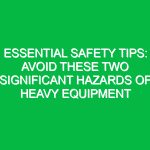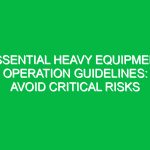“`html
Essential Guidelines for Identifying Heavy Equipment Hazards Safely
Good morning team,
Today, we’re going to discuss an important topic that directly impacts our health and Safety on the job: Essential Guidelines for Identifying Heavy Equipment Hazards Safely. Heavy equipment plays a crucial role in our daily operations, but it also comes with inherent risks. Understanding how to identify and mitigate these hazards is vital for ensuring our Safety and the safety of our colleagues.
Accidents involving heavy machinery can lead to severe injuries and even fatalities, which is why we need to stay informed and proactive about recognizing potential dangers. Let’s dive into the guidelines that will help us work safely around heavy equipment.
Understanding Heavy Equipment Hazards
Heavy equipment hazards refer to the risks associated with operating or working near large machinery such as excavators, bulldozers, and cranes. These hazards can arise from various factors, including mechanical failure, human error, and environmental conditions.
Recognizing these hazards is crucial not only for your safety but also for the safety of your coworkers. A common misconception is that heavy equipment accidents only occur due to operator negligence. However, many incidents can happen even when operators are cautious, emphasizing the need for a comprehensive understanding of potential hazards.
Key Hazards, Risks, and Safety Considerations
Here are some specific hazards associated with heavy equipment:
- Mechanical Failures: Equipment can malfunction unexpectedly, leading to serious accidents.
- Operator Errors: Inexperienced operators may misjudge distances or make poor decisions under pressure.
- Environmental Factors: Weather conditions such as rain, snow, or fog can reduce visibility and traction.
- Bystander Risks: Workers not directly involved in equipment Operation can be injured if they are too close.
- Load Instability: Improperly secured loads can shift or fall, posing risks to everyone nearby.
The consequences of ignoring safety protocols can be dire. From injuries requiring medical attention to fatalities, the cost of neglecting safety is too high. Remember, safety is a shared responsibility, and it’s crucial to stay vigilant.
Best Practices, Procedures, & Actionable Advice
Here are some Best Practices to follow when working with heavy equipment:
1. Conduct Pre-Operation Inspections
Before operating any heavy machinery, perform a thorough inspection to identify potential hazards:
- Check fluid levels (oil, coolant, fuel).
- Inspect brakes, steering, and lights.
- Look for leaks or signs of wear and tear.
2. Use Proper Personal Protective Equipment (PPE)
Always wear appropriate PPE, including:
- Hard hats to protect against falling objects.
- Steel-toed boots to prevent foot injuries.
- High-visibility vests to enhance visibility.
3. Follow Safe Operating Procedures
Always adhere to established operating procedures:
- Only operate equipment you are trained to use.
- Use hand signals or communication devices when working with others.
- Keep a safe distance from bystanders and ensure they are aware of your activities.
4. Stay Alert and Focused
Distractions can lead to accidents. Stay focused on your task and avoid using mobile phones or engaging in conversations while operating machinery.
5. Report Hazards Immediately
If you notice any unsafe conditions, report them to your supervisor right away. Early detection can prevent accidents before they happen.
Real-World Examples
Consider a recent incident where an operator failed to inspect their equipment, resulting in a hydraulic failure mid-operation. The machine rolled over, causing injuries to nearby workers. This incident underscores the necessity of following pre-operation inspections and safety protocols. Let’s learn from these examples and remain vigilant.
Regulations, Standards, and Compliance
Familiarize yourself with relevant safety Regulations and Standards, including:
- Occupational Safety and Health Administration (OSHA) regulations.
- ISO standards related to Heavy Equipment Safety.
- Your company’s specific safety policies and procedures.
Compliance with these regulations is not just a legal requirement; it’s essential for protecting your health and safety on the job. Always ask questions if you are unsure about the standards that apply to your work.
Employee Engagement & Discussion
Now, let’s open the floor for discussion. What safety challenges have you encountered related to heavy equipment? Have you seen any close calls or incidents that could have been avoided? Sharing these experiences can help us all learn and improve our safety practices.
Conclusion & Key Takeaways
To wrap up, remember that identifying heavy equipment hazards is critical for maintaining a safe workplace. By following the essential guidelines we discussed today—conducting inspections, wearing PPE, adhering to safe operating procedures, staying alert, and reporting hazards—you can protect yourself and your colleagues.
Let’s commit to prioritizing safety in everything we do. Thank you for your attention and for your commitment to creating a safer work environment for everyone.
“`


